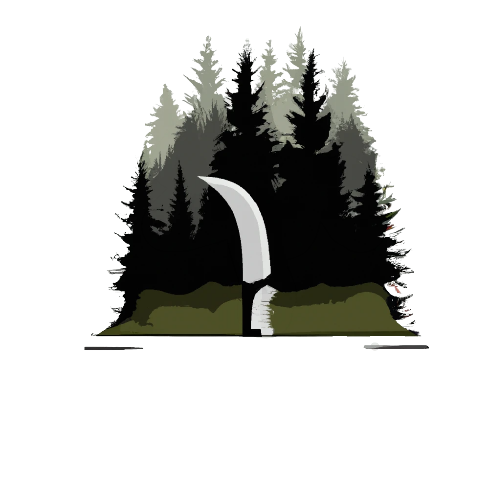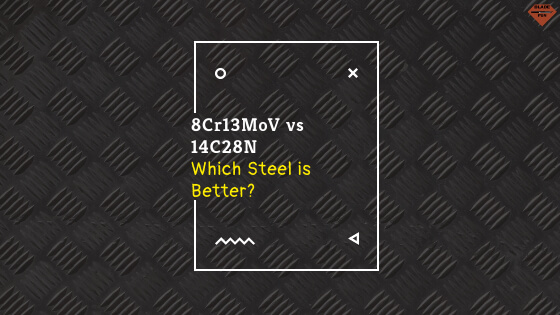Both 8Cr13MoV and 14C28N are budget steels–and with budget steels, it’s often pretty tough to know the difference. After all, they’re nearly all the same. So, which one’s better?
8Cr13MoV and 14C28N are both useful in different scenarios: 14C28N takes a better edge and has more corrosion resistance, but 8Cr13MoV is easier to sharpen and slightly tougher. 14C28N is generally considered better, but the differences are usually fairly small: Choose whichever steel you like more.
Most of the time, 14C28N will win out over 8Cr13MoV. But there are some times you’d want to have 8Cr13MoV over 14C28N. When are those times? Let’s look a bit closer at each of them to find out.
The Main Differences
The main differences between the two steels are edge retention, ease of sharpening, toughness, corrosion resistance, and price.
In terms of edge retention and ease of sharpening (which are usually inversely related), 14C28N has better edge retention but worse ease of sharpening, and 8Cr13MoV has better ease of sharpening but worse edge retention.
It’s a tradeoff with those two traits: You’re going to be sharpening the 14C28N less, but when you do sharpen it, it’ll be tougher–vice versa for the 8Cr13MoV.
14C28N can also get a finer edge than 8Cr13MoV, meaning it’ll not only have a longer-lasting edge, but it will cut better. 14C28N is often used in blades where things need to be sharp–like scalpels–if that tells you anything.
In terms of toughness, 8Cr13MoV wins out slightly over 14C28N because it has more carbon–and carbon is what gives steel its strength. It’s unlikely you’ll notice too much of a difference here.
14C28N has more chromium, which means it’s more corrosion resistant than 8Cr13MoV. Though, you’re unlikely to notice too much of a difference because they’re both budget steels.
In terms of price, this is likely where you’ll notice the most difference: 14C28N is more expensive 8Cr13MoV. So, if you’re looking for a cheap beater knife (the times when you’d want 8Cr13MoV over 14C28N), then go with 8Cr13MoV. If you want a higher quality, sharper knife (14C28N is a steel used in medical equipment like scalpels, after all), then go with 14C28N.
It is important to note that the differences in these two knife steels (and all knife steels, for that matter) can vary greatly depending on the edge geometry, heat treat, maintenance, and more of the blade. For instance, a good heat treat on a mediocre steel will outdo a mediocre heat treat on a good steel.
It’s just something to note that comparing knife steels in a vacuum like we are now doesn’t always reflect the reality of the situation.
8Cr13MoV
8Cr13MoV is a stainless steel usually made in China. (The “stainless” part means that it’s resistant to rust.)
The seemingly cryptic name of 8Cr13MoV actually refers to the steel’s composition. The 8 refers to the percentage of carbon (0.8%), the Cr13 refers to the percentage of chromium (about 13%), the Mo refers to molybdenum, and the V refers to vanadium.
8Cr13MoV is also in a series of steel, in which you may also see steels like 8Cr14MoV. They all follow the same naming pattern: The first number (8 in this case) denotes the percentage of carbon in the steel (0.8% carbon in this case).
The second number (14 in 8Cr14MoV) is the number denoting the percentage of chromium. In 8Cr14MoV, it means that it has 14% chromium, which means that it’s higher than 8Cr13MoV and has more corrosion resistance.
The Mo still means molybdenum and the V still means vanadium.
The full composition of 8Cr13MoV is about:
- 0.8% carbon
- 13% chromium
- 0.3% molybdenum
- 0.25% vanadium
- 1% silicon
- 1% manganese
All those components each do different things: The carbon increases strength (it’s important to note that at high levels, carbon leads to brittleness, which means easy chipping and breaking), the chromium increases corrosion resistance, the molybdenum increases hardenability (which basically means that it’s easier to harden, and thus manufacture), and vanadium improves wear resistance and strength. Manganese increases strength and hardness. Silicon does too, but to a lesser extent.
8Cr13MoV is the kind of steel you can beat up, chip, break, roll, or just plain lose without feeling too bad–the price point makes it nearly impossible to. If that’s what you’re looking for, then go with 8Cr13MoV.
14C28N
14C28N was requested by Kershaw from Sandvik. They wanted a more corrosion resistant steel than Sandvik’s 13C26 steel. The result was 14C28N. Kershaw was able to exclusively use it for about a year before it became available to more knife manufacturers (or other companies that use steel).
In terms of the chemical composition of 14C28N, it’s about:
- 0.62% carbon
- 14% chromium
- 0.2% silicon
- 0.6% manganese
- 0.11% nitrogen
Nitrogen in steels increases the strength and edge retention.
When you put all that together, you get the fine edge-taking steel that is 14C28N.
Basically…
If you need a beater knife that you won’t feel bad about losing or destroying (because it’s cheap), go with 8Cr13MoV. If you need a knife that can hold a finer edge and is higher-end, go with 14C28N.
Recommended Knives
If you’re looking for some knives with 14C28N or 8Cr13MoV (or just some inspiration), here are some of my favorites. Incidentally, Kershaw tends to use both 8Cr13MoV and 14C28N the most out of all the big name knife brands.
Kershaw Brawler – 8Cr13MoV
The Kershaw Brawler (Amazon) is a snappy black folding knife with a tanto blade and the SpeedSafe assisted opening system and a flipper. It’s got 8Cr13MoV steel, a liner lock, and glass-filled nylon handles with a 4-position pocket clip. Overall, if you’re looking for a snappy assisted opening knife, you’ll enjoy this one.
Kershaw Shuffle II – 8Cr13MoV
If you want a knife in 8Cr13MoV that doesn’t have assisted opening, then that’s where the Shuffle II (Amazon) comes in. It’s a small, lightweight multi-function knife that comes in multiple colors. It’s got a thumb stud (manual) opening, a liner lock, a bottle opener, a pry bar, and a flat-head screwdriver.
If you’re looking for something a little more low-profile (and multi-faceted), you’ll be better off with the Shuffle II than with the Brawler.
Kershaw Leek – 14C28N
The Kershaw Leek (Amazon) is another snappy, SpeedSafe assisted knife by Kershaw. It’s got 14C28N blade steel, a thumb stud and flipper opening, a frame lock, and a little safety lock on the bottom of the knife. It’s also got a steel handle and a reversible pocket clip (though, it’s unfortunately not ambidextrous).
If that at all interests you, you can check it out further here.
Kershaw Blur – 14C28N
I told you that Kershaw used these knife steels the most…
The Kershaw Blur (Amazon) is one of their most popular knives. Sometimes, it’ll come with D2 steel, but this one comes in 14C28N. It’s got a stonewashed blade, a nice, blue aluminum handle with Trac-Tec inserts for better grip, Kershaw’s SpeedSafe system with a thumb stud to open it, a liner lock, and a reversible pocket clip (unfortunately not 4-way, though).
The Blur is also designed by the same person who designed the Kershaw Leek–Ken Onion. If you’re interested in checking out the Blur, you can look at it further here.
If you’re interested in learning more about knife steels, seeing more knife steel comparisons, learning about knives, and more, then we’ve got a bunch of articles you’ll probably enjoy. If you’re interested, you can check them out here.

